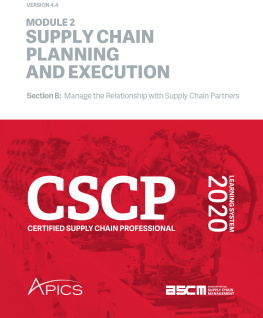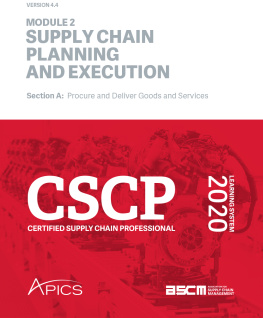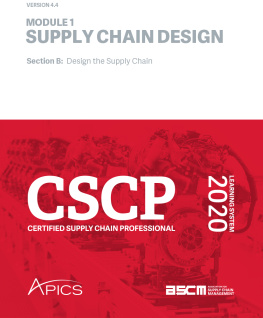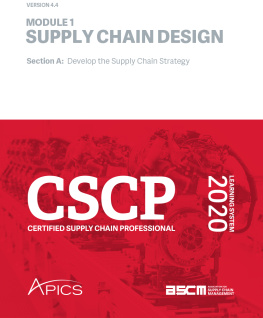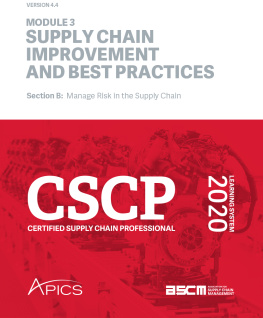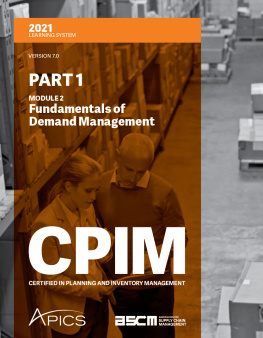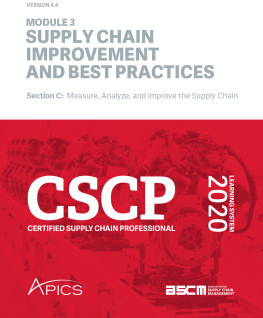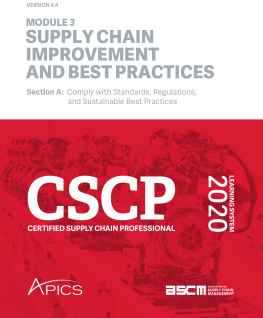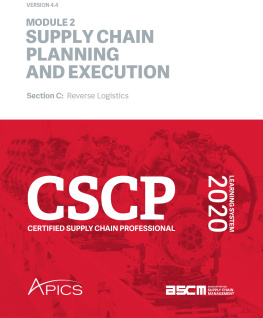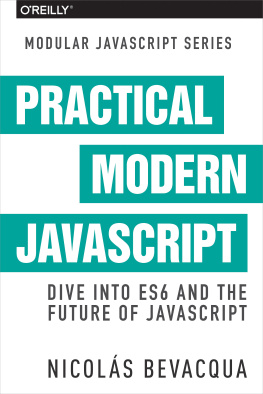APICS - CSCP 2020 Module 2 Section B
Here you can read online APICS - CSCP 2020 Module 2 Section B full text of the book (entire story) in english for free. Download pdf and epub, get meaning, cover and reviews about this ebook. genre: Business. Description of the work, (preface) as well as reviews are available. Best literature library LitArk.com created for fans of good reading and offers a wide selection of genres:
Romance novel
Science fiction
Adventure
Detective
Science
History
Home and family
Prose
Art
Politics
Computer
Non-fiction
Religion
Business
Children
Humor
Choose a favorite category and find really read worthwhile books. Enjoy immersion in the world of imagination, feel the emotions of the characters or learn something new for yourself, make an fascinating discovery.
- Book:CSCP 2020 Module 2 Section B
- Author:
- Genre:
- Rating:3 / 5
- Favourites:Add to favourites
- Your mark:
- 60
- 1
- 2
- 3
- 4
- 5
CSCP 2020 Module 2 Section B: summary, description and annotation
We offer to read an annotation, description, summary or preface (depends on what the author of the book "CSCP 2020 Module 2 Section B" wrote himself). If you haven't found the necessary information about the book — write in the comments, we will try to find it.
CSCP 2020 Module 2 Section B — read online for free the complete book (whole text) full work
Below is the text of the book, divided by pages. System saving the place of the last page read, allows you to conveniently read the book "CSCP 2020 Module 2 Section B" online for free, without having to search again every time where you left off. Put a bookmark, and you can go to the page where you finished reading at any time.
Font size:
Interval:
Bookmark:
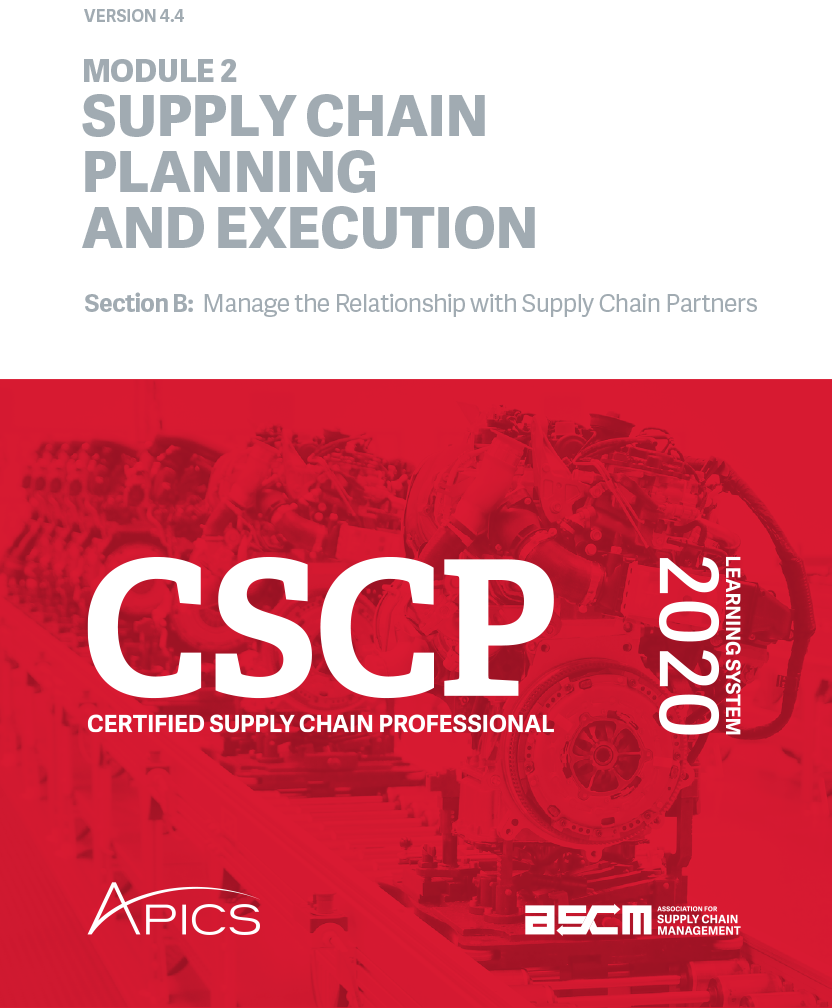
This section focuses on customer relationship management (CRM) and supplier relationship management (SRM). CRM is developed and implemented as a social relations strategy that has some enabling technologies. It fulfills requirements for improved demand management, customer service, and alignment of customer-facing processes and resources. CRM helps create and maintain demand for the products and services being produced. SRM requires an understanding of the underlying concepts, the enabling technologies, and the requirements for improved management of sources of supply. While CRM focuses on creating demand, SRM helps ensure that this demand can be fulfilled in a way that delivers profit to all members of the supply chain and satisfaction to the supply chain customers.
Managing relationships begins as soon as the organization has customers and suppliers. Customer and supplier relationship management are important tools for maintaining any level of relationship, but they are very powerful tools to get a relationship to the next level and keep it on that path. These tools are vital for enacting supply chain strategy over the long term.
The key processes that supply chain managers need to be able to perform related to managing the relationship with supply chain partners are
Managing relationships with customers
Managing relationships with suppliers.
The following is a general overview of these processes. The information required to plan and execute these processes is presented in this sections chapters.
The process of managing relationships with customers involves the following steps:
Using change management to develop a culture, organizational structure, and philosophy of putting the customer first and deepening customer relationships whenever possible
Acquiring customer relationship management software to capture data on every interaction with the customer regardless of point of contact
Grouping customers into meaningful segments to target communications and prioritize level of service toward the most profitable customers
Understanding each segments needs and wants by
Capturing data on customer interactions and preferences
Analyzing data to design product/service packages for each given customer segment
Producing segment-tailored product/service packages
Learning how wants and needs differ during the product life cycle
Gathering feedback for a continuous improvement cycle
Listening to and talking with customers to develop lifetime relationships
Sharing information on customer constraints, priorities, and wants and needs with extended supply chain partners
Eliminating non-value-added products, features, or services
Tailoring messages to improve prospect conversion, vulnerable customer retention, customer win-back, and customer loyalty
Capturing customer service measurements to measure overall program success
Using metrics in a feedback loop to improve the CRM program
The process of managing relationships with suppliers involves the following steps:
Using change management to internally align the organization to promote information sharing, collaboration, and mutual profitability
Acquiring supplier relationship management software to automate transactional interactions, monitoring, measurement, and analysis with any level of supplier and information sharing with key suppliers
Calculating total cost of ownership for key supplier materials
Selecting the right partners for the given strategy
Developing goals with suppliers for achieving a desired relationship type
Negotiating mutually profitable contracts and ground rules
Appointing managers for key supplier relationships or alliances
Developing long-term relationships with key material suppliers
Working with strategic allies to add value to products, reduce operational costs, enable strategic or market growth, and hone each partys expertise
Realigning processes, information flows, and workflows to eliminate your or your suppliers redundancies or non-value-added work
Measuring or auditing supplier performance and compliance with voluntary requirements or certifications
Conducting periodic course corrections based on performance
Reevaluating selected suppliers periodically for strategic fit
This chapter is designed to
Describe reasons to identify and understand market segments
Define the concepts behind customer-focused marketing
Describe the benefits of market segmentation
Describe how markets can be segmented by demographics, attitudes, or psychological profiles or by customer value, customer needs, or preferred contact channel
Describe the Pareto effect in relation to customer value
Explain how customer information can be used to understand the wants and needs of each segment.
Potential customers form a very large group that can be segmented based on market analysis and information from existing customers. Segmentation can be based on any number of criteria selected to suit a particular purpose, and each class may be segmented in more than one way. Market segments can be defined by demographic characteristics such as gender, geography, age, occupation, and wealth. Demographic categories can also be refined or customized. For example, geographic segmentation could be based on the likelihood of visiting a particular retail location, by ZIP or area code, or by zones that contain relatively equal demand (i.e., the size of each zone would vary). Customers can also be segmented by attitudes or psychological profiles, such as willingness to engage in social media or self-identification in a social group such as a biker or a wine lover.
During product or service design or redesign, marketing can ask more specific questions about the potential market. As always, the basic questions are the best questions: Who? Where? When? Why? What? How many? In other words, who is interested in the new product, and where are they located? Are they low-income urban apartment dwellers, suburban homeowners, or farmers and ranchers? The answers to such questions constitute segmentation.
The primary reason to identify and understand market segments is to increase the organizations profits (or its equivalent) over the long term.
According to the APICS Dictionary, 16th edition, customer segmentation is
the practice of dividing a customer base into groups of individuals that are similar in specific ways relevant to marketing. Traditional segmentation focuses on identifying customer groups based on demographics and attributes such as attitude and psychological profiles.
When discussing market segments in a supply chain, there may be more than one perspective of who the customer is. For example:
Font size:
Interval:
Bookmark:
Similar books «CSCP 2020 Module 2 Section B»
Look at similar books to CSCP 2020 Module 2 Section B. We have selected literature similar in name and meaning in the hope of providing readers with more options to find new, interesting, not yet read works.
Discussion, reviews of the book CSCP 2020 Module 2 Section B and just readers' own opinions. Leave your comments, write what you think about the work, its meaning or the main characters. Specify what exactly you liked and what you didn't like, and why you think so.

